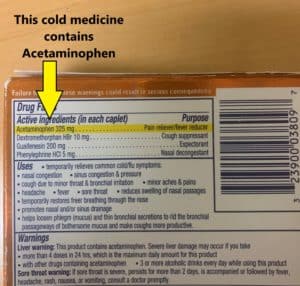
If you were to ask a poison center what category of medications they receive the most calls about, a resounding answer would be PAIN RELIEVERS! Poison centers across the county, including the Missouri Poison Center, handle multiple calls every day about both prescription and over-the-counter (OTC) pain relievers. Some of these calls are questions about safe use, double doses, concerns about pain relievers in pregnancy, or children getting ahold of a bottle.
There are two main types of oral OTC pain relievers.
- Acetaminophen, which is the name of the active ingredient. Other names include: TYENOL®, Excedrin®, Midol®, Goody’s® and many store brands.
- Nonsteroidal anti-inflammatory drugs (NSAIDS) which include one the following active ingredients:
- Aspirin: Bayer®, Bufferin®, Goody’s®, Excedrin®
- Ibuprofen: Advil®, Motrin®
- Naproxen Sodium: Aleve®, Naprosyn®
Both types of OTC pain relievers treat mild to moderate pain, but they also reduce fevers, which is why these ingredients are commonly found in OTC cold and flu products. Let’s take a closer look at three topics that are important for the safe use of OTC pain relievers.
Safe storage

Children are curious by nature, and it makes sense that they are usually even more curious when it comes to medication. Many OTC pain relievers are flavored, chewable, or syrupy and look and taste like candy. Medications are one of the leading causes of childhood poisoning. To help prevent this, make sure to put all medicines up and out of sight of children.
It may seem like a good idea to keep OTC pain relievers out on a counter or on a nightstand for quick dosing, but take the extra step and put the medication away each and every time. Also, make sure to check that the child-resistant lid is threaded properly and sealed tight as you put it away. It may be surprising, but young children are able to open child-resistant lids, especially if they are not properly closed.
Safe Dosing
 Just because a medication is over-the-counter, does not mean you can forget about reading the directions. It is important to read the Drug Facts label for the correct dosage, how often to take it, and possible interactions or warnings with its use. If you have questions about the Drug Facts label, ask your health care provider or call the Poison Help Line at 1-800-222-1222 before taking the medicine.
Just because a medication is over-the-counter, does not mean you can forget about reading the directions. It is important to read the Drug Facts label for the correct dosage, how often to take it, and possible interactions or warnings with its use. If you have questions about the Drug Facts label, ask your health care provider or call the Poison Help Line at 1-800-222-1222 before taking the medicine.
Many children’s varieties of OTC pain relievers are liquid and it is important to use the dosing cup or syringe that comes with the product. The use of a household teaspoon or tablespoon is never recommended as the amount can vary widely. If you don’t have the proper device, ask your pharmacist. It is best to use a child’s weight rather than age to determine a dose. Make it a practice to know or write down your child’s weight because this can be important information for medication safety. Ask your child’s pediatrician for a dosage chart or confirm dosage with a healthcare provider before giving.
Some adults take larger or more frequent doses of OTC pain medications to try and get a faster or more powerful effect. This can be dangerous and may lead to an overdose. For example, acetaminophen has a maximum daily dose of no more than 4,000 mg total in a 24-hour period. If more is taken, either intentionally or by mistake, there is a serious risk of liver injury. Quick medical attention is necessary for adults and children even if no early sign or symptoms are noticed.
Additionally, it is important to watch for hidden pain relievers in other common medications such as those for cold, flu, menstrual relief, sleep, or in prescription pain relievers. In fact, more than 500 medications contain acetaminophen in some form. If you want to review your OTC medicines, this worksheet is a great way to learn more: https://www.getreliefresponsibly.com/sites/getreliefresponsibly_us/files/compare_pain_relievers.pdf
Safe disposal
Safe and proper disposal is important for all expired or unneeded medications including OTC pain relievers. Take advantage of a medication disposal program in your area. Pharmacies or police departments often offer them.
If there is not a program available in your area, follow these steps:
- Take your drugs out of their original containers.
- Liquids should be poured over paper towels, kitty litter, or used coffee grounds. Place the tightly wrapped mixture into a disposable container with a lid, such as an empty margarine tub, or into a sealable bag.
- Solids (pills, capsules, tablets) may be mixed with undesirable substances such as used coffee grounds or kitty litter so that they are less likely to be eaten. Place the tightly wrapped mixture into a disposable container with a lid, as above.
- Conceal or remove any personal information, including prescription number, by covering it with permanent marker or duct tape, or by scratching it off.
- The sealed container with the drug mixture and the empty drug containers can now be placed in the trash.
DO NOT: Flush expired or unwanted drugs down the toilet or drain unless the label or accompanying patient information specifically instructs you to do so.
DO: Return unwanted or expired prescription and over-the-counter drugs to a drug take-back program or follow the above steps for household disposal.
For any questions or concerns about over-the-counter pain relievers, call the Poison Help line at 1-800-222-1222. Specially trained nurses and pharmacists are available 24/7/365 to answer your questions. The service is free and confidential.
